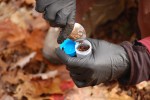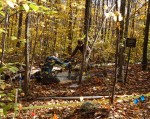The Joint Genome Institute of the U.S. Department of Energy recently granted Harvard Forest LTER co-PIs Jeffrey Blanchard (UMass), Kristen DeAngelis (UMass), Linda van Diepen (U. of New Hampshire), Serita Frey (U. of New Hampshire), and Jerry Melillo (MBL) a Community Sequencing Program award to aid in the study soil microbial changes over time. With this facilities award, DOE will pay the costs of DNA/RNA library preparation, sequencing, and basic computational processing for three terabases of metagenomic (community DNA) and metatranscriptomic (community RNA) data gathered from Harvard Forest soils.
The project, overseen by researchers with expertise in ecosystem ecology, biogeochemistry, microbial ecology and genomics, aims to characterize the microbial communities from several long-term soil warming experiments at the Forest. The three warming projects, ongoing for six, nine, and 20 years respectively, correspond to three distinct phases of projected carbon dioxide emissions. The DNA/RNA chronosequence resulting from this award will help researchers understand how climate change affects soil microbial community composition and activity over time.
Microorganisms are difficult to classify using visible morphology, which is the usual practice. But DNA analysis enables researchers to determine which microbes are present in the soil, while RNA sequencing provides a view of which microbes are actively contributing to ecological processes. A 2012 summer Research Experience for Undergraduates (REU) group project at the Forest helped to prototype the DNA sequencing analysis for this project.
Sequencing three terabases (3,000,000,000,000 DNA bases) is roughly equivalent to sequencing 1,000 human and plant genomes, 10,000 ant genomes or 500,000 bacterial genomes. The sequencing and data processing will take two to three years.
By Jeffrey Blanchard and Linda van Diepen (HFR)

 Enlarge this image
Enlarge this image

